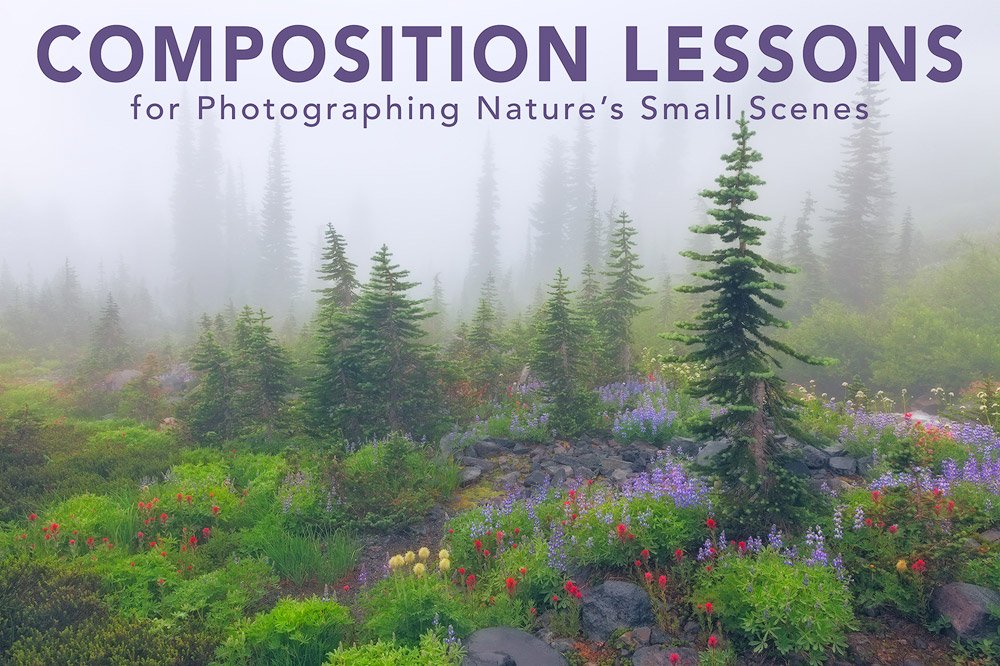Are you ready to move beyond the formulaic and repetitive composition advice You find online?
If so, this course is for you.
For most photographers, building strong composition skills is a years-long endeavor that includes a lot of time in the field focused on experimentation, with some successes and many failures along the way. While putting in this time is an essential part of the creative process, we designed this ebook, the field guide, and the video case studies to help you accelerate your learning.
Rather than repeating the rigid rules and simplistic basics you find in online articles and YouTube videos (see: use the rule of thirds, look for leading lines), this course focuses on teaching composition and design concepts—tools for your toolbox that you can apply in a wide variety of scenarios to a broad range of subjects. Composition Lessons takes an accessible approach with a focus on practical advice paired with inspirational ideas that you can immediately use to improve your photographs.
Price: $39 for the ebook, field guide, and video case studies.
Composition Lessons Includes:
131-Page PDF ebook featuring more than 160 photos to help bring the composition concepts to life and 10 exercises to help you practice your composition skills out in nature. Photo examples include successes, failures, and alternative views to deepen your learning.
A 21-Page PDF Field Guide that you can download to your smartphone to use as a quick reference while in nature. The field guide includes summaries of the most important information from the ebook, including exercises you can practice to improve your observation and composition skills.
Six Video Case Studies to reinforce the ideas from the ebook and give you ideas for how you can assess your compositions, both in the field and when you get home (70 minutes).
Price: $39 for the ebook, field guide, and video case studies.
Who will get the most from this course?
While the composition concepts are relevant to all forms of nature photography, the ebook and video case studies focus on the lessons most relevant to photographing intimate landscapes, creative portraits of plants, and abstract renditions of natural subjects. You will get the most from this course if you are able to take the ideas from the ebook and videos and practice them outside in nature.
EXAMPLE PAGES FROM THE EBOOK

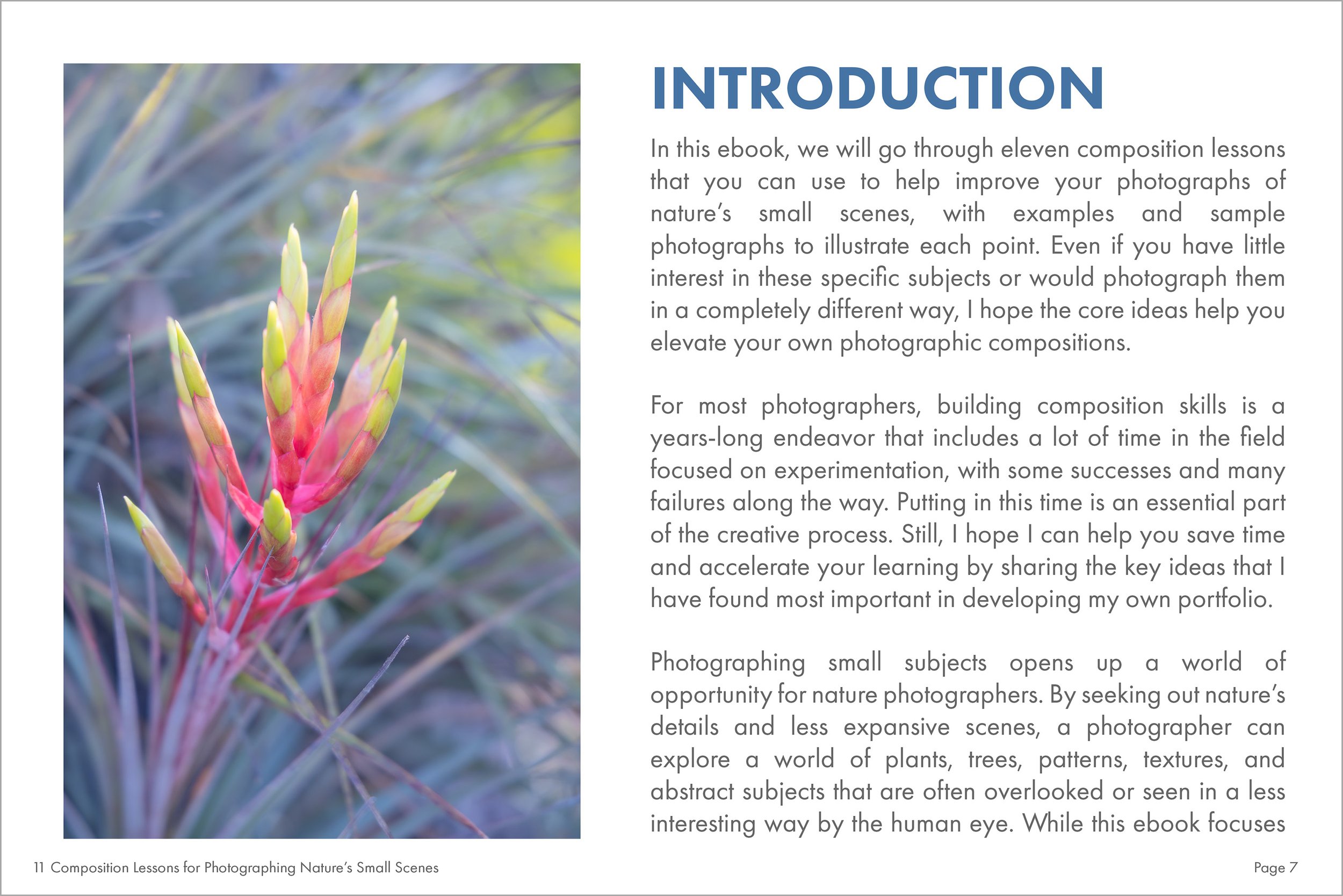


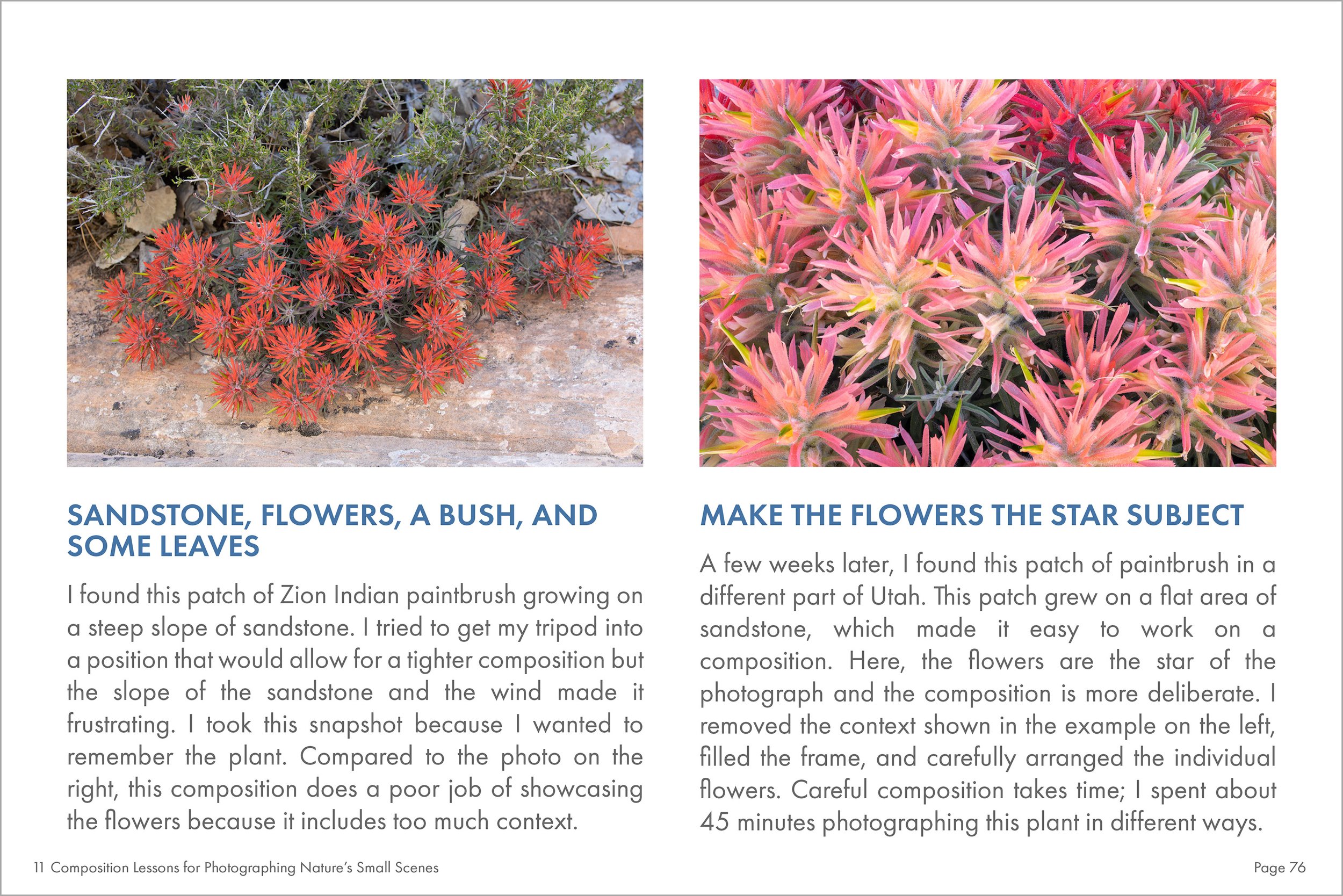
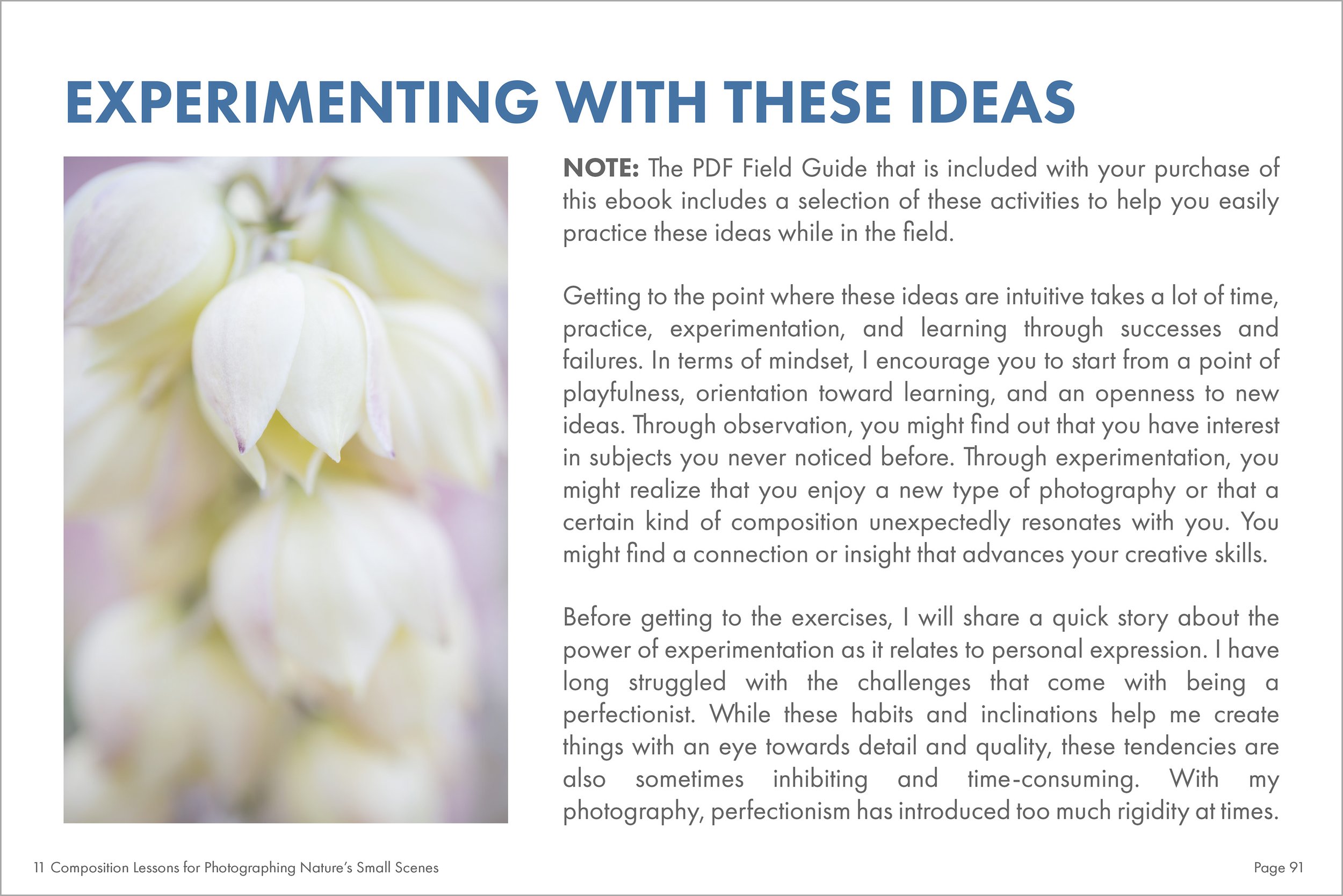
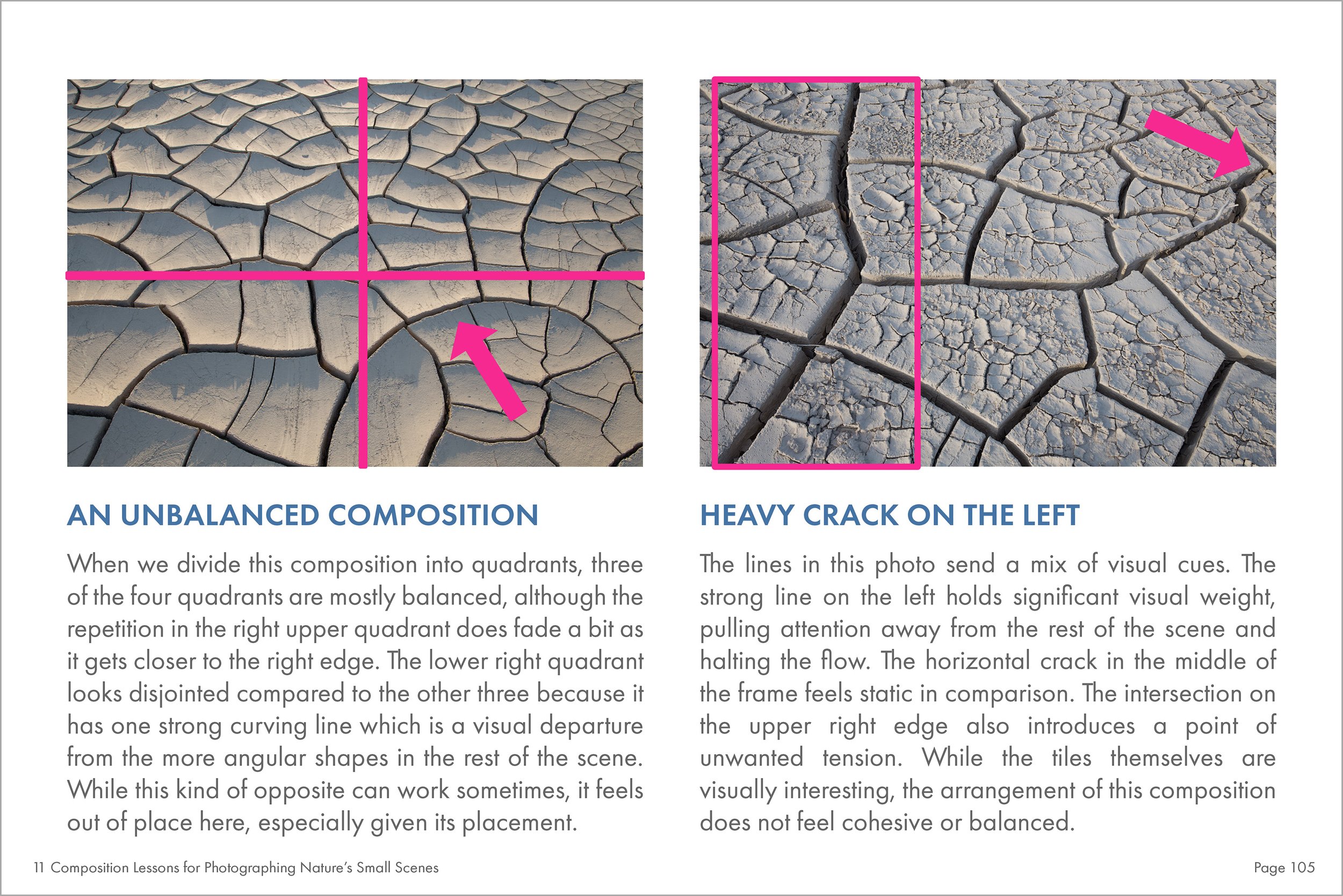
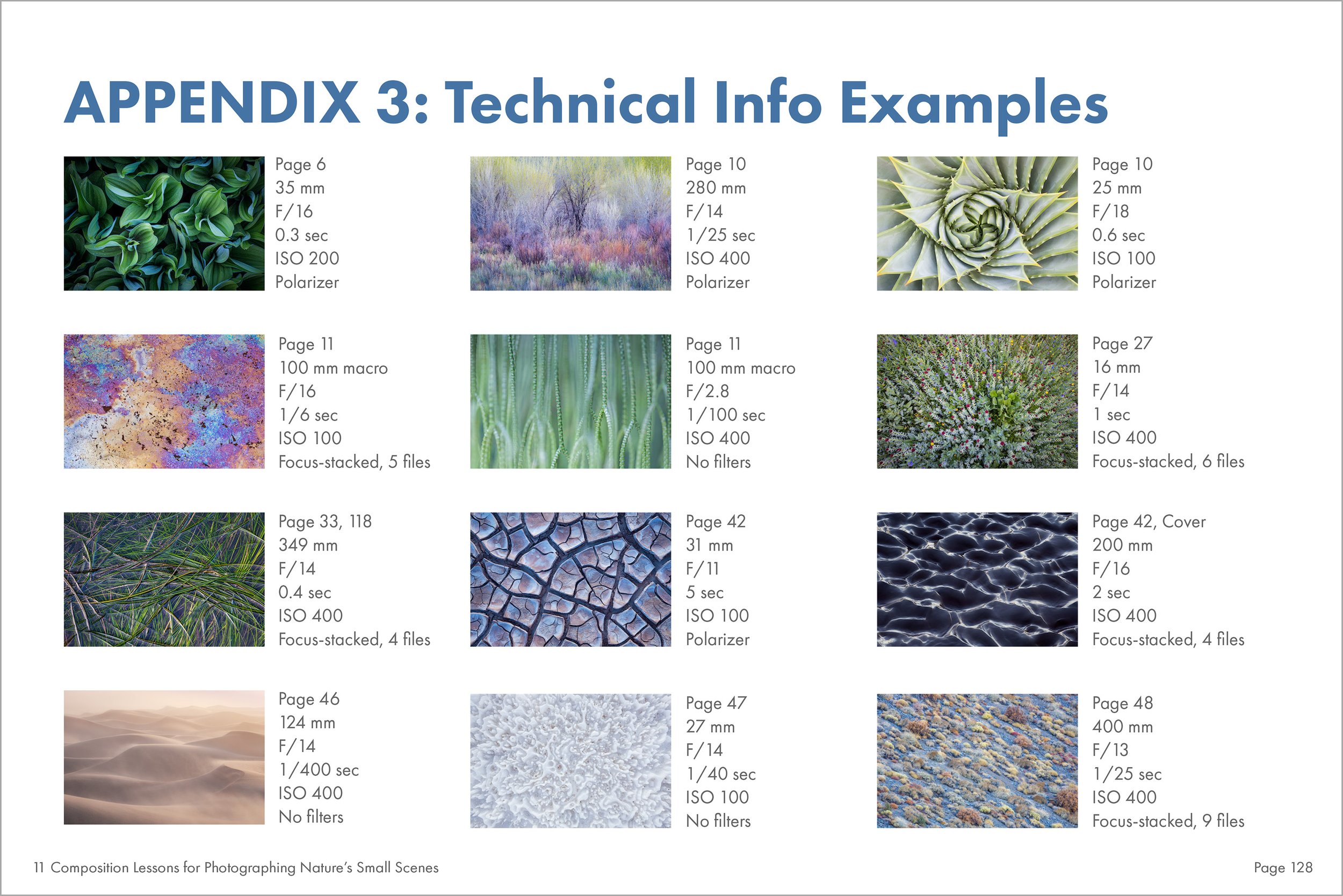
selected Photographs from 11 Composition Lessons
This sample gallery includes a small portion of the photographs that are included as lessons in the e-book, field guide, or video case studies. The composition lessons are focused on essential concepts for crafting creative, cohesive photographs of nature’s small scenes like those you see below.
Reviews and Feedback for This Course
“Sarah’s most recent book on the ‘Composition Lessons for Photographing Nature’s Small Scenes’ is an information-packed visual and intellectual journey behind the scenes of some of the most striking small scenes images in landscape photography today. Not to be outdone by her written word, her video case studies are excellent highlighting subtle differences in images and what she could have done to photograph the scene differently. I found so much value in this book and will put it at the top of the list of recommendations to my clients who want to refine or restructure the way they interact with the landscape.”
“Sarah’s ebook, ‘Composition Lessons for Photographing Nature’s Small Scenes,’ contains more information and a higher level of detail than in any other resource of its kind. It was extremely insightful how Sarah walks you through her process and approach from the moment she arrives in the field all the way through post processing. I found the lessons enlightening and conveyed in a format which was easy to comprehend. This ebook has provided me with a whole new thought process that I can apply when I arrive in the field.”
“I have admired Sarah’s beautiful imagery ever since I got into photography. She has a very thoughtful, deliberate approach which reflects in all of her artwork, and her new ebook, ‘Composition Lessons,’ is no exception. Sarah walks us through her refined thought process in a detailed and easily comprehensible manner that instantly strikes inspiration for things we can try next time we are in the field. I have always known Sarah to be a great teacher with a wealth of information to share, and this ebook is another demonstration of her years of experience and wisdom clearly explained and well presented.”
“Sarah Marino’s ‘Composition Lessons for Photographing Nature’s Small Scenes’ is a fantastic resource for new and experienced photographers alike. She uses her expertise in photographing small scenes to distill a complex topic into clear, logical concepts, each supported by dozens of example images. Several real case studies are also provided to cohesively tie everything together. I can’t recommend this ebook enough!”
“In ‘Composition Lessons,’ Sarah Marino delves deeply into the mindset, theory, and observational skills photographers need to create intentional and impactful compositions. Though the lessons focus on photographing small natural scenes, they can be applied to any visual art. The ebook and videos provide countless examples of both beautiful, successful images and relatable, unsuccessful images that further strengthen the comprehensive and insightful lessons. She writes in such a clear and pragmatic way that I was even able to take great pictures in my own backyard while reading it, and I am excited to apply these lessons out in the field!”
“I just finished a fantastic ebook from fabulous landscape photographer, Sarah Marino. This ebook is exceptionally well done and provides very in-depth and detailed lessons focused on composition and small scenes. Sarah has also included several videos in support of the book!! If you love and enjoy landscape photography and intimate scenes, Sarah is one of the best!”
“I absolutely adore Sarah Marinos’s new ebook, ‘Composition Lessons for Photographing Nature’s Small Scenes.’ The premise of the book is improving any photographer’s ability to recognize, appreciate, and compose smaller scenes. But it so much more than that! These 11 Lessons range from thinking thru why we make images, visual design and compositional elements, balance and visual flow, eliminating distractions, and photo editing. The lessons direct the reader to think thru our compositions, to ask questions about our favorite images. What works, what doesn’t, and how could it be better? Sarah supplies sample images as examples that work; and these are fabulous examples. But she also supplies us with images that do not work as well. Not many photographers I know would be willing to go to those lengths to help us grow. My favorite part of the entire package is the Field Guide - it’s awesome! Almost every person I know, who does any type of photography, carries and uses their phone for scouting, framing, checking setting references and the like. The Field Guide opens access to these composition lessons, in the field, where and when it matters most. I know it’s already made me a better photographer and I believe it will help you as well.”
“Sarah Marino’s ‘Composition Lessons’ package is one of the most complete resources for small scene photography. We have all seen photography books and online resources with examples of great images. Sarah has plenty of those, but she goes a step further. Sarah shows images that did not quite work - and she gives you the background and explanations to understand why. Perhaps the most important concept in Sarah’s eBook is her approach to nature photography. She advocates identifying and understanding your personal connection to what you photograph in nature. This may very well transform a hobby into a passion.”
“This ebook is for everyone wanting to improve their photography, no matter what type of photography you enjoy and it might open new areas for you to explore. I think this ebook is very well done. Comparing photos that worked with those that didn’t is exceptionally helpful.”
“I’ve been wanting to improve my images of intimate landscapes and abstracts and this ebook gave me a lot of tips and ideas to work with! With smaller scenes you just have less elements to work with for composition and interest and they require a different approach, both in the field and with post-processing. Sarah covers these topics and much more in this clearly written ebook, accompanied by beautiful examples. With lessons on visual design principles, training observation skills, and many different video case studies I’m very happy with this extensive ebook.”
“I’ve been a fan of Sarah Marino’s images for some time and have purchased and viewed several of her tutorials. She is an outstanding nature photographer and her ‘Composition Lessons for Photographing Nature’s Small Scenes’ is about something she obviously knows very well and loves. This is evidenced by the great photos demonstrating the concepts and also by the straightforward and clear explanations on how she accomplishes these images. From beginner to advanced photographer, anyone wanting to explore and photograph more of this world, the smaller natural scenes all around us, this work will benefit you.”
“‘Composition Lessons for Photographing Nature’s Small Scenes’ is a suite of tools you will find with difficulty somewhere else. It’s an illustrated eBook with Sarah’s own photos, coming with a companion Field Guide when you’re in the field, and also with six video case studies explaining practically the points treated in the eBook. All this material is simple enough to be understandable by everybody, and complex enough to let you think twice before taking a photograph. Sarah, as she calls herself, is a perfectionist; I would prefer call her an artisan. Reading her book is like walking with somebody in a workshop explaining to you with passion what the tools are and how to work with them effectively. It may be at times overwhelming because there are a lot of instruments to know and because Sarah is exacting with herself. Some pictures she considers as failures would be great in my portfolio! But this sensation of drowning under a lot of information dissipates pretty quickly when you realize that Sarah is giving you the best of her knowledge to let you take better pictures. What she gave us is a series of ideas to “help create more refined photographs.” In another words, Sarah’s sole purpose with all these tools is to offer us an opportunity to be better at expressing what we feel for a particular scene. I had the chance, during a workshop, to see Sarah “working a scene.” It’s pretty impressive and the only thing I can say is that she applies what she preaches, and with a smile. This book was not written to be read quickly; you have to practice what Sarah advises by taking your camera (or not!) in a familiar scene and start ... observing. From there it is a very long walk, but the journey, not the picture, is the final purpose: keep learning and always walk forward!”
“As a part-time professional photographer concentrating on landscapes and flowers, I find Sarah Marino’s new ebook, ‘Composition Lessons for Photographing Nature’s Small Scenes,’ to be another wonderful contribution by Sarah to the body of available photography instructional literature. Like Sarah’s photography, it is thoughtful and well organized. The ebook is also beautifully and plentifully illustrated with Sarah’s photographs — many successes and some self-admitted failures — all serving to support and enhance the accompanying lessons. Most importantly, this is not a book about “rules” of composition. Rather, Sarah continually urges readers to discard confining rules in favor of applying compositional concepts to make deliberate and intentional choices, and provides a variety of helpful tools to improve their compositional skills. Sarah also encourages readers to be open to playfulness and experimentation in working on their composition skills, and offers inspiration to explore new ways to see the world through the camera lens. This ebook already has energized me to have fun with a compositional approach that I have only dabbled with previously — and that may not make it into my portfolio — but that will enrich my time with my cameras. I recommend Sarah’s new ebook to photographers of virtually any skill level seeking to breathe new life and new insight into their photography.”

